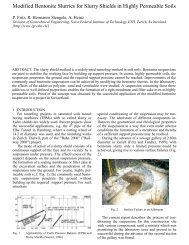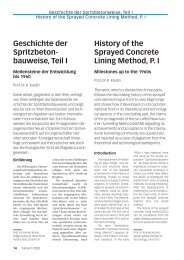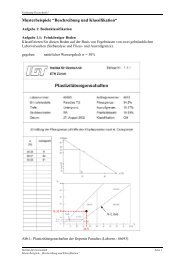Geschichte der Spritzbetonbauweise, Teil IV - ETH - IGT
Geschichte der Spritzbetonbauweise, Teil IV - ETH - IGT
Geschichte der Spritzbetonbauweise, Teil IV - ETH - IGT
Erfolgreiche ePaper selbst erstellen
Machen Sie aus Ihren PDF Publikationen ein blätterbares Flipbook mit unserer einzigartigen Google optimierten e-Paper Software.
ausgezeichnet bewährt, wo<br />
früher ein zeitrauben<strong>der</strong><br />
schwerer Holzeinbau angeordnet<br />
wurde. Mit dem<br />
Spritzbeton ist dem Stollenbauer<br />
ein Mittel in die Hand<br />
gegeben, dessen Anwendung<br />
sehr anpassungsfähig ist, sowohl<br />
in <strong>der</strong> Stärke des Auftrages,<br />
als auch in den Flächenabmessungen.<br />
Die Ausführung<br />
stört den Vortrieb nur<br />
ganz kurzfristig“. Ferner<br />
stellte er fest, dass „ein direkt<br />
hinter dem Vortrieb aufgespritztes<br />
Gewölbe in den<br />
meisten Fällen den nachfolgenden<br />
Wirkungen des Gebirgsdruckes<br />
standhält“. Frey-<br />
Bär schließt seine Ausführungen<br />
mit einem detaillierten<br />
Kostenvergleich <strong>der</strong> einzelnen<br />
Stützmittel je Tunnelmeter<br />
und sagt: „Es ist dabei<br />
zu bedenken, dass die drei eigentlich<br />
ganz verschiedenen<br />
Einbauarten (Anker, Spritzbeton<br />
und Stahlbogen) sehr<br />
wohl miteinan<strong>der</strong> kombiniert<br />
werden können“. Der<br />
<strong>Geschichte</strong> <strong>der</strong> <strong>Spritzbetonbauweise</strong>, <strong>Teil</strong> <strong>IV</strong><br />
History of the Sprayed Concrete Lining Method, P. <strong>IV</strong><br />
2 Spritzbeton und Anker bei den Maggia-Kraftwerken, Schweiz, 1952–1955 (Fotos D. Pra<strong>der</strong>)<br />
2 Use of shotcrete and bolts in the waterway tunnels of the Maggia Hydroelectric Scheme, Switzerland 1952–1955<br />
(Photos courtesy of D. Pra<strong>der</strong>)<br />
österreichische Ingenieur<br />
Rabcewicz schrieb 1964 rückblickend:<br />
„Die erste erfolgreiche<br />
Anwendung <strong>der</strong> Oberflächenstabilisierung<br />
mittels<br />
Spritzbeton für Tunnel in instabilem<br />
Gebirge als integrieren<strong>der</strong><br />
Bestandteil des Vortriebes<br />
anstelle <strong>der</strong> Verwendung<br />
von Zimmerung o<strong>der</strong><br />
Stahleinbau wurde in dem<br />
Lodano-Mosogno Stollen für<br />
die Maggia-Kraftwerke in <strong>der</strong><br />
Schweiz zwischen 1951 und<br />
1955 durchgeführt“ (Bild 2).<br />
Im Hinblick auf den seit 1920<br />
weltweit erfolgten Einsatz<br />
des Spritzbetons ist diese Behauptung<br />
selbstredend falsch.<br />
Sie zeigt lediglich, dass <strong>der</strong><br />
Autor erst nach dieser Anwendung<br />
die Bedeutung des<br />
Spritzbetons als Stützmittel<br />
erkannt hat.<br />
In Österreich kam Senn’s<br />
Spritzbetonmaschine (geliefert<br />
durch die Firma Aliva,<br />
Schweiz) zum ersten Mal bei<br />
<strong>der</strong> Wasserkraftanlage Prutz-<br />
Imst von 1953 bis 1955 sowie<br />
ter excavation is in most cases<br />
capable of withstanding subsequent<br />
effects of rock pressure”.<br />
Frey-Bär concludes his<br />
paper with a detailed comparison<br />
of the costs per tunnel<br />
metre of the individual support<br />
measures and says: “It is<br />
to be taken into consi<strong>der</strong>ation<br />
that the three quite different<br />
support elements (rock bolts,<br />
shotcrete and steel sets) can<br />
perfectly well be used in combination”.<br />
The Austrian engineer<br />
Rabcewicz wrote in 1964 in<br />
retrospect: “The first successful<br />
application of surface stabilisation<br />
by means of shotcrete<br />
for tunnels in unstable<br />
ground as an integral part of<br />
the driving process, instead of<br />
using timber or steel, was for<br />
the Lodano-Losogno tunnel of<br />
the Maggia Hydroelectric<br />
Scheme, in Switzerland, 1951-<br />
1955” (Fig. 2). In view of the<br />
continuous worldwide application<br />
of sprayed concrete<br />
since 1920, this statement is<br />
of course, not true. It was only<br />
after this use of sprayed concrete<br />
that Rabcewicz himself<br />
discovered its importance as<br />
a means of support.<br />
In Austria, Senn’s shotcreting<br />
machine (supplied at that<br />
time by the Swiss firm AL<strong>IV</strong>A)<br />
was first applied in the Prutz-<br />
Imst Hydroelectric Plant from<br />
1953–1954 and for the<br />
Schwarzach Plant from 1954–<br />
55 (Rotter 1958). As to the use<br />
of sprayed concrete in mining<br />
in Austria, “The Bleiberg mine<br />
can claim to be the first mine<br />
in Austria that had the<br />
courage to break new ground<br />
in the field of sprayed concrete<br />
(AL<strong>IV</strong>A machine 1957) –<br />
apart from a first test in the<br />
Salt Mine Bad Ischl in 1953”<br />
(Rainer 1961). In Italy in 1958,<br />
the 15.2 km long waterway<br />
tunnel (Ø = 7 m) for the<br />
Monastero Hydroelectric Plant<br />
(Como) was lined with shotcrete<br />
using the previously<br />
mentioned shotcreting machine.<br />
Worthy of note is the<br />
Tunnel 5/2002 13






